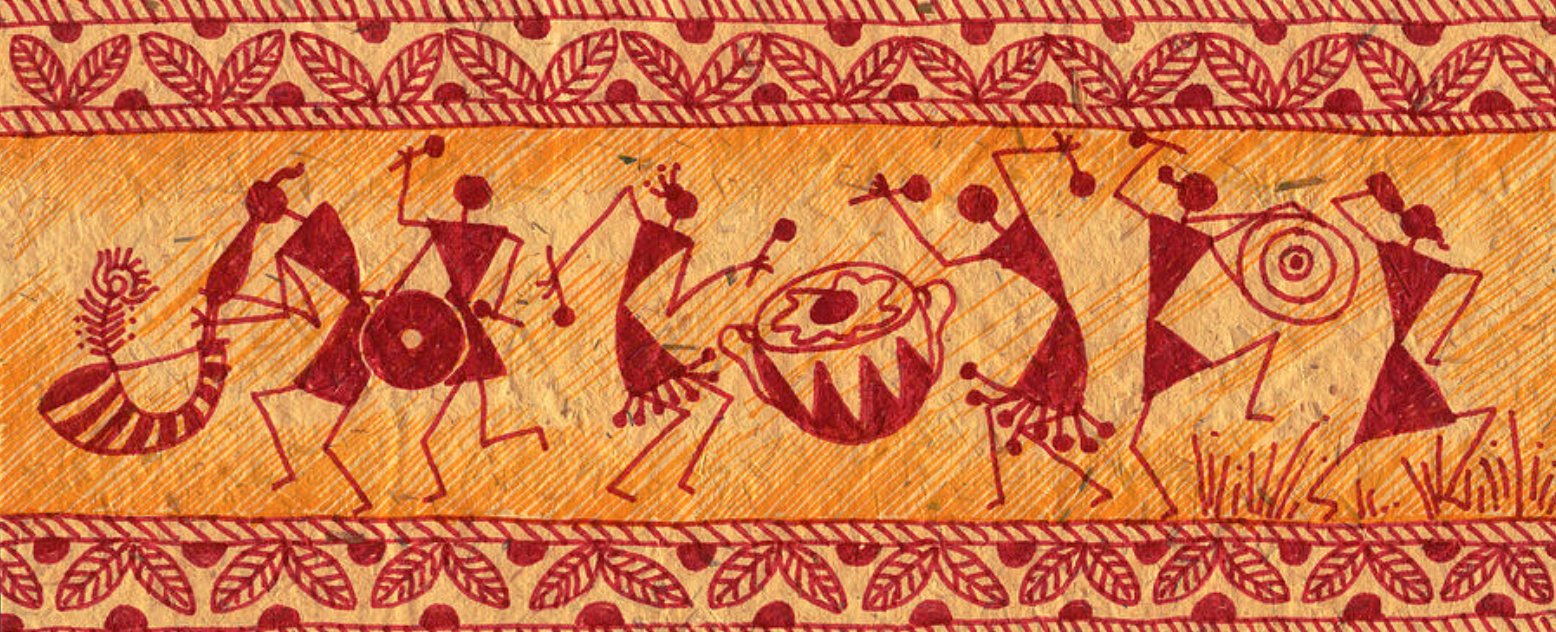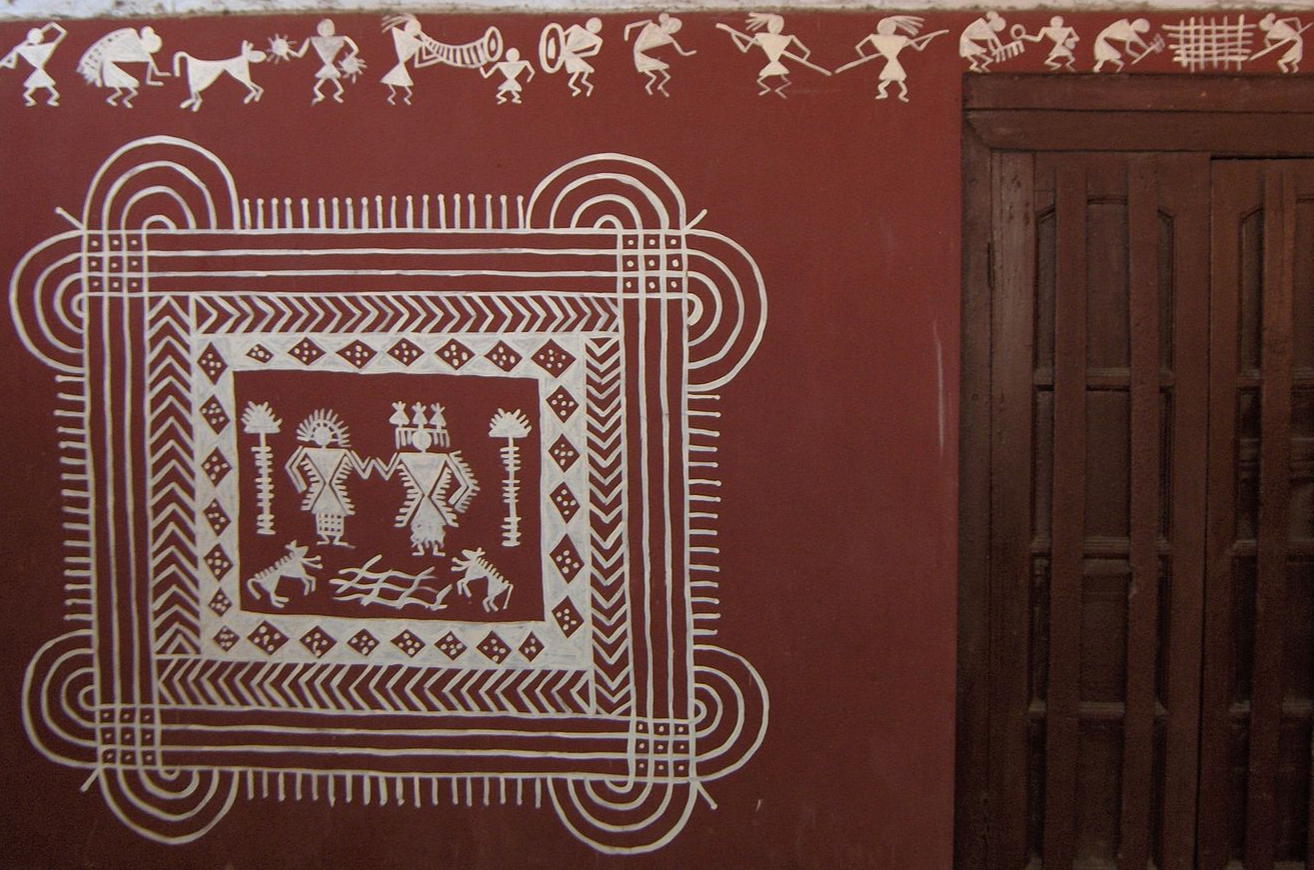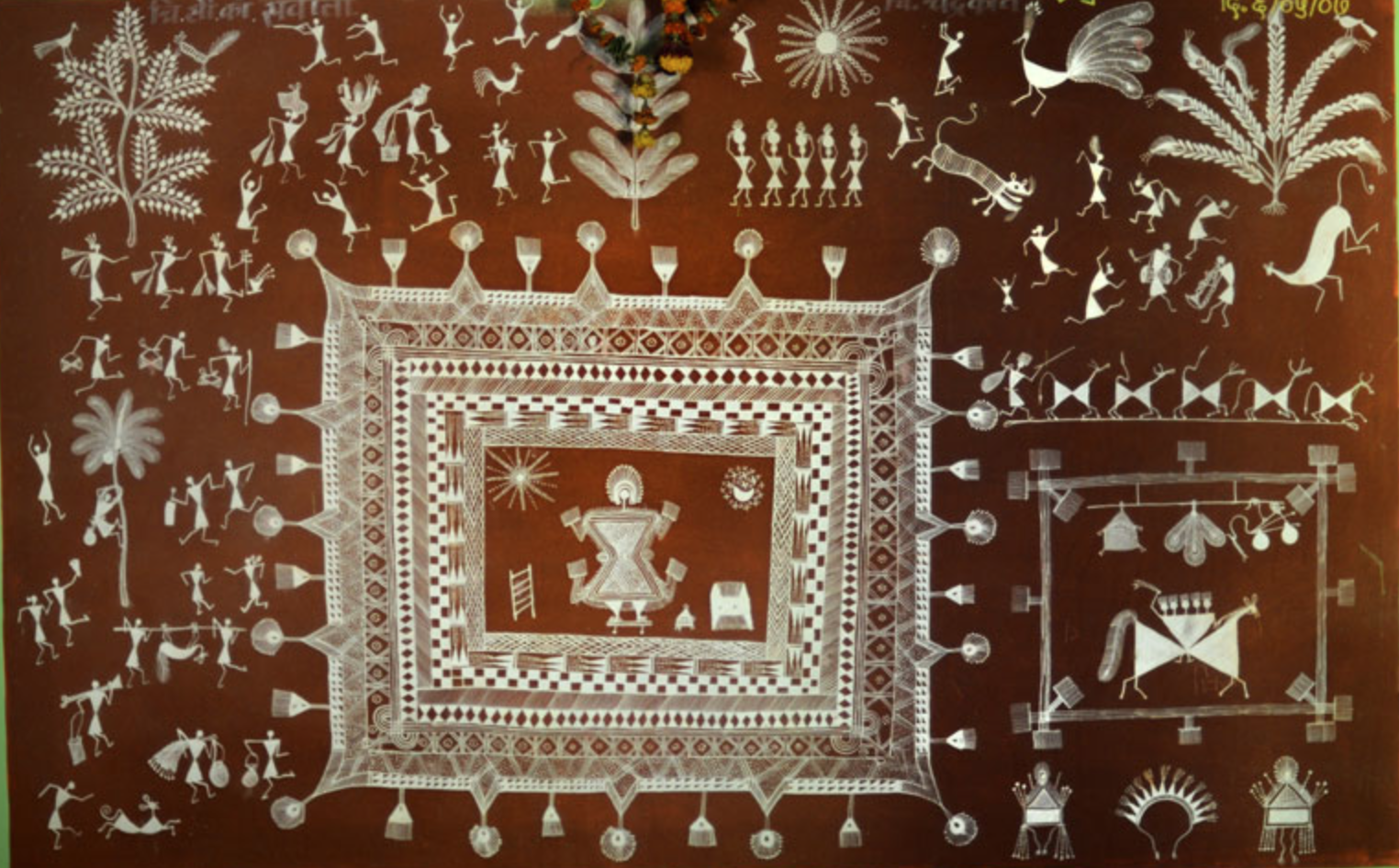Warli Art : A labour of Identity and Custom
Part 2 of Series - Chitra: A Journey Through India's Art.
Chitra - a word in Sanskrit and Hindi - means a painting or a picture. My series ‘Chitra: A Journey Through India’s Art’ aims to introduce Eastern art forms which may be unheard of, and most likely overlooked in the Western art world. Through this series of blog posts on Round Lemon, I will explore India’s Art and Culture in every nook and corner of the country: So fasten your seat belts and join me on this journey - you ardent art lovers really don’t want to miss this.
Introduction to Warli Art
Warli art - named after the Warli tribe - is an ancient folk art found mainly in the state of Maharshatra, India. ‘Warli’ is derived from the word ‘Warla’ which means ‘a piece of land’. According to historians, Warli Art’s origins can be traced back to 2,500 – 3000 BC. This Art form was first created on walls of mud houses, however, this has now extended to mediums such as paper and textiles. Warli Paintings have also been granted Geographical Indication under Intellectual Property Rights. This tribal mural art is very different compared to other Indian folk art forms, but also somewhat similar to the African Zulu paintings.
Themes of Warli Paintings
Warli art mostly portrays customs and credence of the Warli tribe. Important tribal occasions such as Warli harvesting seasons, marriage, celebrations, festivals and folk dancing form the subject of the paintings, along with elements of daily tribal life. Whilst celebration is a key theme, the depiction of nature and god also frequently occur in Warli paintings. Geometry featured is also symbolic of nature, which circles evoking the sun and the moon, with triangles forming a representation of hills and mountains.
Dancing Warli (2010) by Subash Limaye
In this painting, we can see both men and women of the Warli Tribe dancing to the tunes of traditional instruments being played. The heart of the painting is a beating drum, of which the figures are playing. On the left, we can see a Tarpa player. Overall, the figures in this painting depict a lively cacophony of celebration. The figures are sandwiched between a leaf patterned border, symbolic of prosperity. Generally speaking, the speciality of Warli paintings lie in their simplicity. They’re not as intricate as other painting styles, and are relatively easy to draw.
Colours used in Warli Art
Just like with other forms of ancient Indian folk art, Warli Art uses natural pigments sourced from the environment - soil, cow dung, pineapples, turmeric, charcoal and flowers. Any prototypical Warli painting would be made with background colours consisting of black, Indigo, ochre or brick red; because this type of art was traditionally made on the walls of mud houses, using the building’s natural brick red backdrop became a frequent motif. Because of their neutral background colour, Warli paintings tend to be more earthly and toned down, with far less colour to that of other Indian Folk Paintings like Madhubani paintings.
Warli Painting on a wall at Sabarmati Ashram, Ahemdabad, Gujarat, India (taken in 2006)
This Warli painting is created directly onto a wall of a mudhouse. Enclosed within a decorative lace-like border, we can see two human figures hand in hand wearing characteristic dress, as we realise this painting depicts a wedding. A row of figures dance along the top of the building: this important characteristic of celebration draws similarities to Limaye‘s ‘Dancing Warli’.
Warli Art Motifs
There are several Motifs which are commonly used in Warli Art…
1. Devchauk
We often come across square shapes in Warli Art - known as a ‘Chauk’. Devchauk, when translated to English means ‘God’s square’ ( Dev: God, Chauk: square). Devchauk is mostly drawn to symbolise marriage ceremonies. The mother goddess of fertility known as ‘palghat’ is also generally portrayed inside a Devchauk.
Wall Warli Art
The contrast of the brick red against the stark white works effectively to create a crisp, clear image. Depicted inside this Devchauk is goddess Palghat - mother of fertility. She is central to this painting as the tribe’s source of life, ensuring that the Warli tribe coexists peacefully with nature and its contents. In this painting, Animals such as deer, tiger and horse are scattered across the canvas, with birds perched on a tree and a peacock showcasing its feathers. The figures are engaged in various tribal activities such as hunting, collecting water, plucking coconuts from trees, as well as singing, dancing and playing instruments.
2. Tarpa Dance
Tarpa is a traditional tribal musical instrument created from dry bottle gourd, bamboo tubes, cord and wax, with Tarpa dance being a characteristic celebration of the Warli Tribe. The tribe creates a circle by holding hands and dancing around the centre, where the Tarpa player stands. Men and Women of the Warli tribe often choose their life partners through Tarpa dancing events.
Tarpa Instrument
Warli Painting by Jivya Soma Mashe
This painting is symbolic of a Warli village celebrating a festival: You can see the Tarpa player in the centre, circled by hundreds of tribal dancers. The huts and trees surrounding the villagers set the scene of their close-knit environment. The geometry within this painting is multilayered: Whilst you initially encounter a large spiral of people (symbolic for the path of enlightenment), you look closer to discover that the figures themselves are also formed from triangles – two inverted triangles joined through the tips. The upper triangle symbolises torso while the lower triangle indicates the pelvis.
3. Communities
Human Figures in Warli Art are often used to depict tribal ceremonies or activities.
Warli painting (undated) picture by Raju Kasambe
This painting is dominated by human figures contributing to Warli civilisation through activities such as household chores, fetching water, taking care of children and gathering firewood. The rhythm and body language of the figures evokes a strong sense of community and belonging.
4. Holi Festival
‘Holi’ is the festival of colour, and is known to be one of the main festivals of Hinduism. In the Indian state of Maharashtra - which is also the home of the Warli Tribe - the festival of Holi marks the beginning of the new year, generally falling in March.
Holi festival (undated) by Malati Rinjad
This painting portrays a pyre being lit - a ritual called ‘Holika Dahan’. This particular ritual symbolises the victory of good over evil, depicted symbolically through a geometric triangle shape. Clustered in the top left corner are the moon and stars, indicating the nighttime occurrence, with figures celebrating in the moonlight.
5. Nag Panchami Festival
In Hinduism, almost every aspect of nature is worshipped. Nag Panchami is a Hindu festival which commemorates the existence of the Snake God, and this motif is only explored in Art during August, around the time of the festival.
Nag Puja (Nag Panchmi), (undated) by Prachi Gorwadkar
In this depiction of Nag Panchmi, three snakes dominante the foreground of the painting. Figures can be seen celebrating, holding instruments called Pungi or ‘Been’ in the Hindi language, which is used to arouse snakes. Small black coloured bowls are filled with milk as an offering to the snakes. Some people believe that offering milk to snakes will protect one’s family from evil energy, while some say that offering milk will negate the astrological imbalances of planetary positions.
6. Birds and Animals
Cows, Buffalos, Goats, Bulls and dogs are common motifs in Warli paintings to symbolize farming during sowing or harvesting seasons. These are also accompanied by birds such as Hens, peacocks, and Sparrows.
Warli Farming ( 27th July 2010) by Subash Limaye
This painting depicts a typical working day for Women in the Warli Tribe. The Women are working through both rain and sun, showing their dedication and adaptability. The main harvest animal shown here is a goat tied to a peg and being milked, with a large bird dominating the upper half of the canvas of the tree. The bird is like the onlooker for the Womens work.
7. Marriage
Marriage is one of the most essential ceremonies of the Warli Tribe. A typical Warli Painting has common features of a Marriage ceremony, consisting of Gods, the bride and groom, small symbols of nature, domestic animals and the celebratory Tarpa Dance.
Warli Wedding (2010) by Subhash Limaye
This Warli Tribe wedding procession has a celebratory atmosphere. The Devchauk motif is featured at the centre of the painting with the couple inside.
Expansion of Warli Painting
With Warli Art’s growing popularity on both a national and international level, the art form has transitioned from being painted traditionally on mud houses towards canvas, walls, bags, clothes and pottery. However, like many other Indian Folk art, Warli art cannot be translated on footwear, as it is considered too sacred.
Warli Painting on a Tote bag displayed at REDBUBBLE. Design by Manjiri Bhave
The tote bag is a more contemporary, commercial and fashionable form to depict Warli Art. It deviates from traditions slightly with a vibrant gradient background, playful in colour and evocative of a sunset. This example evidences that Warli Art is still being practiced today and remains a relevant and prominent form of art.
Conclusion
From Ancient traditionalism to carving a niche in the fashion industry: Warli Art has come a long way. Whilst this Art form has expanded through its medium, the common themes and principles of celebration, customs and traditions remain the same. Hopefully Warli Art identity will continue to be celebrated for many generations to come.
Bibliography
Patil , K. ( 2017) Warli Art: Diversification of traditional painting creating future , hope and happiness. Available online at: https://www.homesciencejournal.com/archives/2017/vol3issue3/PartF/3-3-70-220.pdf
Sarade , M. (2021) Warli Art- The Indigenous Tribal Artform that expresses Lige through Geometry. Available online at : https://www.exoticindiaart.com/article/warli-art-the-indigenous-tribal-art/
Illustrations
Limaye, S. Dancing Warlis (27th July 2010). Available online at https://fineartamerica.com/featured/dancing-warlis-subhash-limaye.html
Warli Painting done a wall at Sabarmati Ashram , Ahemdabad. Available online at. https://commons.wikimedia.org/wiki/File:Warli-art-2.jpg
Warli art done on a wall. (undated). Available online at : https://www.dsource.in/gallery/warli-painting-1
The Sliva Store Bamboo Tribal Musical Instrument, Golden Yellow. Available at online at : https://www.amazon.in/Silva-Store-Bamboo-Musical-Instrument/dp/B074M9717J
Mashe, JS. (undated). Available online at : https://commons.wikimedia.org/wiki/File:A_Warli_painting_by_Jivya_Soma_Mashe,_Thane_district.jpg
Kasambe , R. (undated ). Avilable online at: https://commons.wikimedia.org/wiki/File:Warli_Paintings_SGNP_by_Raju_Kasambe_DSCF0200_(1)_04.jpg
Rinjad, M. Warli Art- Holi festival (undated). Available online at : https://www.indiaart.com/childrens-art/child-art-details/22165/warli-art-holi-festival
Gorwadkar, P. Nag Puja (Nag Panchmi), (undated). Available online at https://www.indiaart.com/art-marketplace/painting-details/1854/nag-puja-nag-panchmi-
Limaye, S. Warli Farming (27th July 2010). Available online at : https://fineartamerica.com/featured/warli-farming-subhash-limaye.html
Limaye, S. Warli Wedding (27th July, 2010) Available online at: https://fineartamerica.com/featured/warli-wedding-subhash-limaye.html
Bhave, M.(undated) Warli Painting on a Tote Bag. Available online at: https://www.redbubble.com/i/tote-bag/Warli-Painting-by-manjiri/30863812.PJQVX
Few images are available via license :










